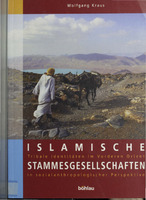Islamische Stammesgesellschaften
Tribale Identitäten im Vorderen Orient in sozialanthropologischer Perspektive
Author(s)
Kraus, Wolfgang
Collection
Austrian Science Fund (FWF)Language
GermanAbstract
This book is the first comprehensive study in German on tribal identity in the Middle East. It includes a comparative and theoretical survey of Muslim tribal societies and a detailed empirical case-study. A separate identity within wider political and cultural communities is one of the most characteristic aspects of Middle Eastern tribes. It is typically expressed in tribal striving for political autonomy - an autonomy practically realized in varying degrees according to historical conditions. The book examines cultural dimensions and practical manifestations of tribal identity in this tension between local particularism and wider belonging.
A critical discussion of the anthropological notion of tribe serves as an introduction to the theoretical part of the book. The insight that the most important common traits of Muslim tribes are located in the cultural and ideological sphere leads on to an examination of the general characteristics of Middle Eastern tribal societies. Then specific cultural models of tribal identity, such as the ideological and practical role of kinship and marriage relations, are examined, and the highly variable practical manifestations of tribal organization are outlined. The first part of the book is concluded by a critical appraisal of competing theoretical approaches to the phenomenon of tribal identity, which forms the basis for the empirical case study.
In the second part, the theoretical approach elaborated in the first part is applied to a case study of a specific tribal society, a central Moroccan Berber tribe. First, the historical and geographical conditions are analyzed. Then the history of the tribe and the various kinds of sources for its understanding are discussed. Further chapters are devoted to the traditional political and legal institutions and their transformations in the course of the 20th century. The hierarchically ordered local status categories and the segmentary structure of the tribe are analyzed in detail. Finally, an investigation of orally transmitted historical knowledge shows that the local discourse about the past is a privileged domain for the study of the ideologies and cultural conceptions that constitute local tribal identity but also contribute to limiting and transcending it.
An important methodological principle followed throughout is that ruptures and contradictions should not be ignored or explained away. The oral historical discourse not only provides an insight into the meaning of tribal identity. It also shows how covertly the dominant ideological models are called into question time and again. Even on the cultural and ideological level, tribal identity can only be understood in its interrelations with the wider identity relating to the Muslim state - interrelations that must be explained as historically conditioned and variable. Das Buch stellt die erste umfassende Auseinandersetzung mit dem Phänomen tribaler Identität im Vorderen Orient in deutscher Sprache dar. Es verbindet eine komparativ und theoretisch orientierte Untersuchung von Gemeinsamkeiten und Unterschieden islamischer Stammesgesellschaften mit einer eingehenden empirischen Fallstudie. Die separate Identität im Inneren umfassenderer politisch-kultureller Gemeinschaften, die Stämme im Vorderen Orient kennzeichnet, drückt sich typischerweise im Streben nach politischer Autonomie aus, das sich je nach historischen Bedingungen in sehr unterschiedlichem Ausmaß realisieren läßt. Das Buch untersucht kulturelle Dimensionen und praktische Erscheinungsformen tribaler Identität in diesem Spannungsfeld.
Am Anfang steht eine kritische Aufarbeitung des sozial- und kulturanthropologischen Stammesbegriffes. Ausgehend von der Einsicht, daß die wesentlichen Übereinstimmungen verschiedener islamischer Stämme im kulturell-ideologischen Bereich zu finden sind, werden allgemeine Charakteristika nahöstlicher Stammesgesellschaften herausgearbeitet. Spezifische kulturelle Modellen tribaler Identität, besonders die ideologische und praktische Rolle der Beziehungen von Verwandtschaft und Heirat, werden ebenso untersucht wie die variablen praktischen Erscheinungsformen tribaler Organisation. Der erste Teil schließt mit einer kritischen Aufarbeitung unterschiedlicher theoretischer Zugänge.
Der zweite Teil wendet am Beispiel eines zentralmarokkanischen Berberstammes die im ersten Teil erarbeiteten theoretischen Perspektive an. Nach einer Analyse der historischen und geographischen Rahmenbedingungen werden die Geschichte des Stammes und die Quellen für ihre Kenntnis sowie traditionelle politische und rechtliche Institutionen untersucht und die Veränderungen skizziert, denen diese im 20. Jh. unterworfen waren. Dann werden die hierarchisch geordneten lokalen Statuskategorien und die segmentäre Gliederung des Stammes im Detail analysiert. Die Auseinandersetzung mit dem oral tradierten lokalen Wissen über die Vergangenheit zeigt schließlich, daß der historische Diskurs der untersuchten Gesellschaft ein privilegiertes Feld für die Untersuchung der Ideologien und kulturellen Konzeptionen darstellt, die einerseits tribale Identität konstituieren und andererseits dazu beitragen, diese zu relativieren und zu transzendieren.
Ein wichtiges methodisches Prinzip ist dabei, das Vorhandensein von Brüchen und Widersprüchen nicht zu ignorieren. Der orale historische Diskurs eröffnet nicht nur einen Einblick in die sinngebenden Zusammenhänge tribaler Identität. Er zeigt auch, wie verdeckt immer wieder die dominierenden ideologischen Modelle in Frage gestellt werden. Auch auf der kulturell-ideologischen Ebene kann tribale Identität nur in ihren Wechselwirkungen mit der übergeordneten islamischen Identität verstanden werden. Diese Wechselwirkungen müssen jedoch als historisch bedingt und somit variabel aufgefaßt werden.
Keywords
tribal identity; Muslim tribal societies; Middle Eastern; oral historical discourse; Ethnologie; Naher Osten; Nordafrika; Stamm; Orale Tradition; Ideologie; Agnat; Ayr; Genealogie; MarokkoDOI
10.26530/oapen_574825ISBN
9783205771869OCN
607232910Publication date and place
2004Grantor
Imprint
BöhlauClassification
Society and Social Sciences


 Download
Download